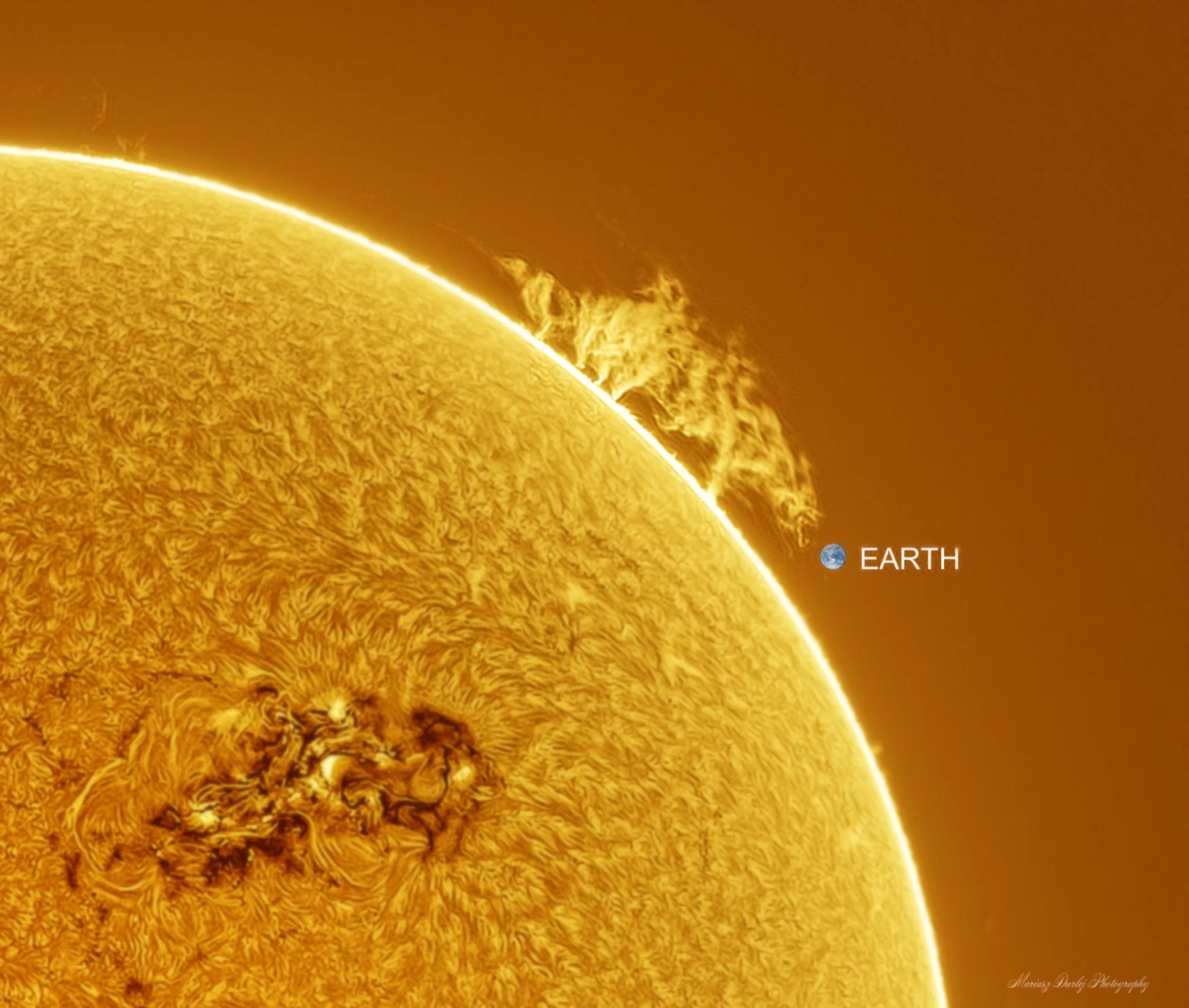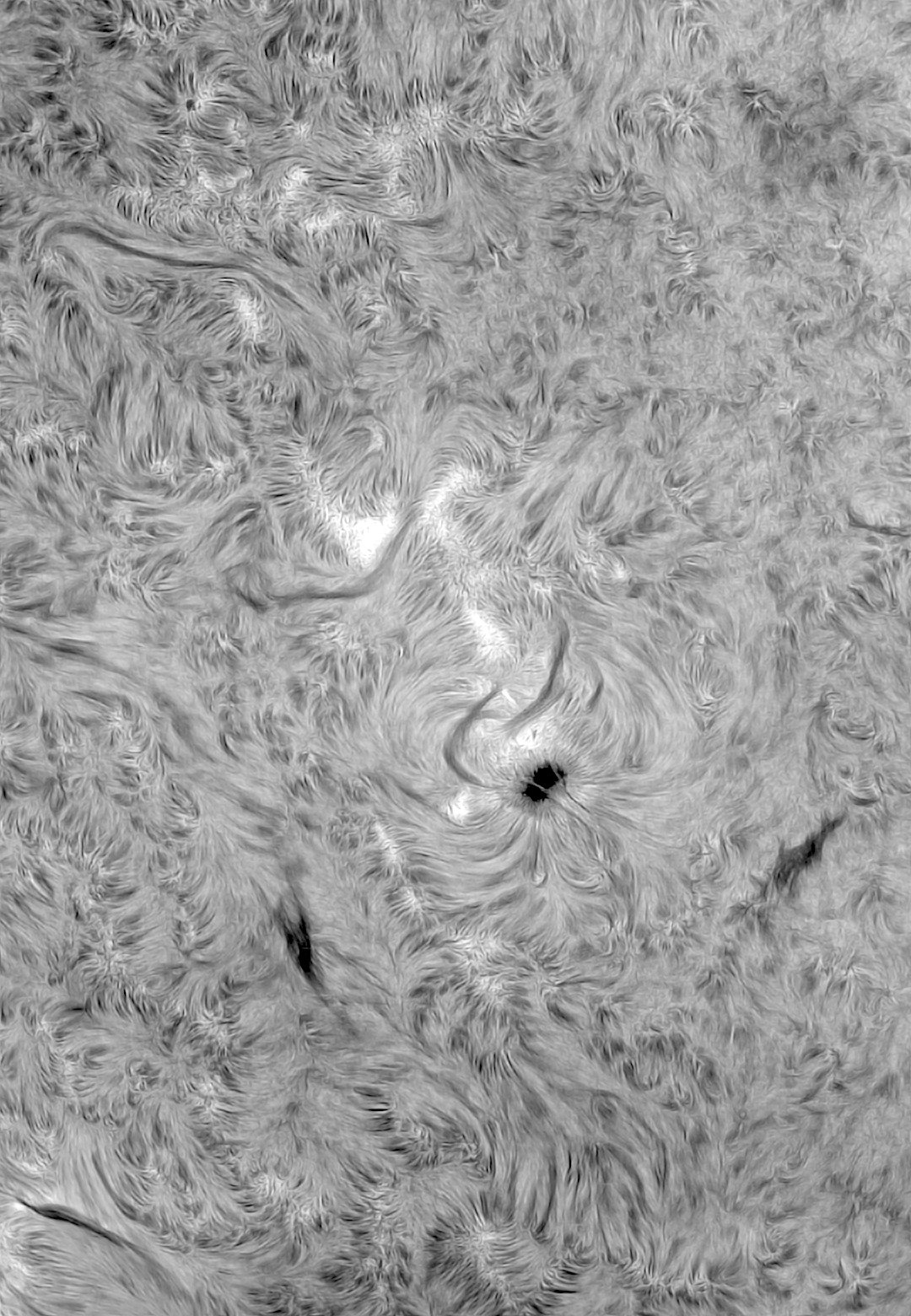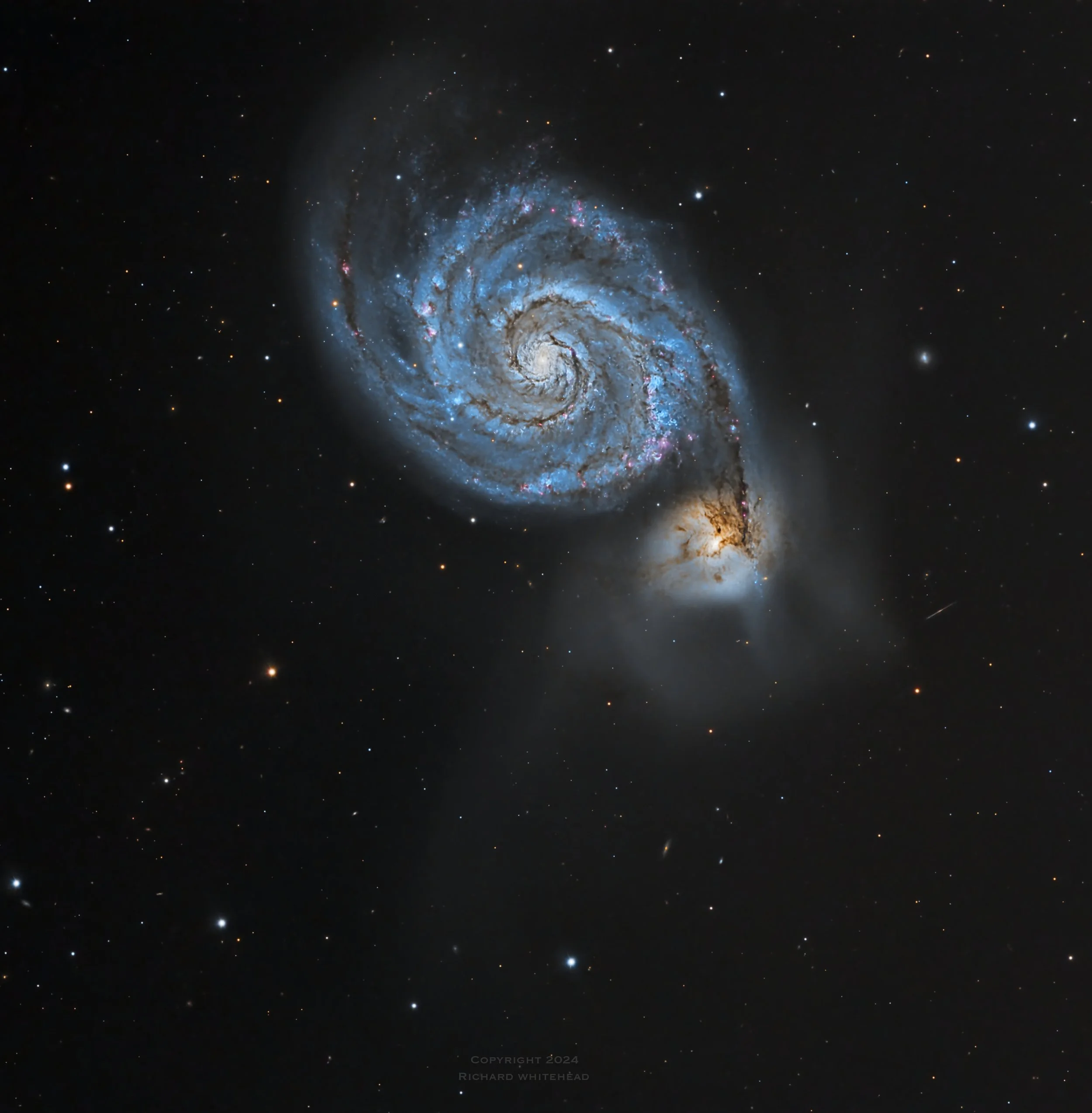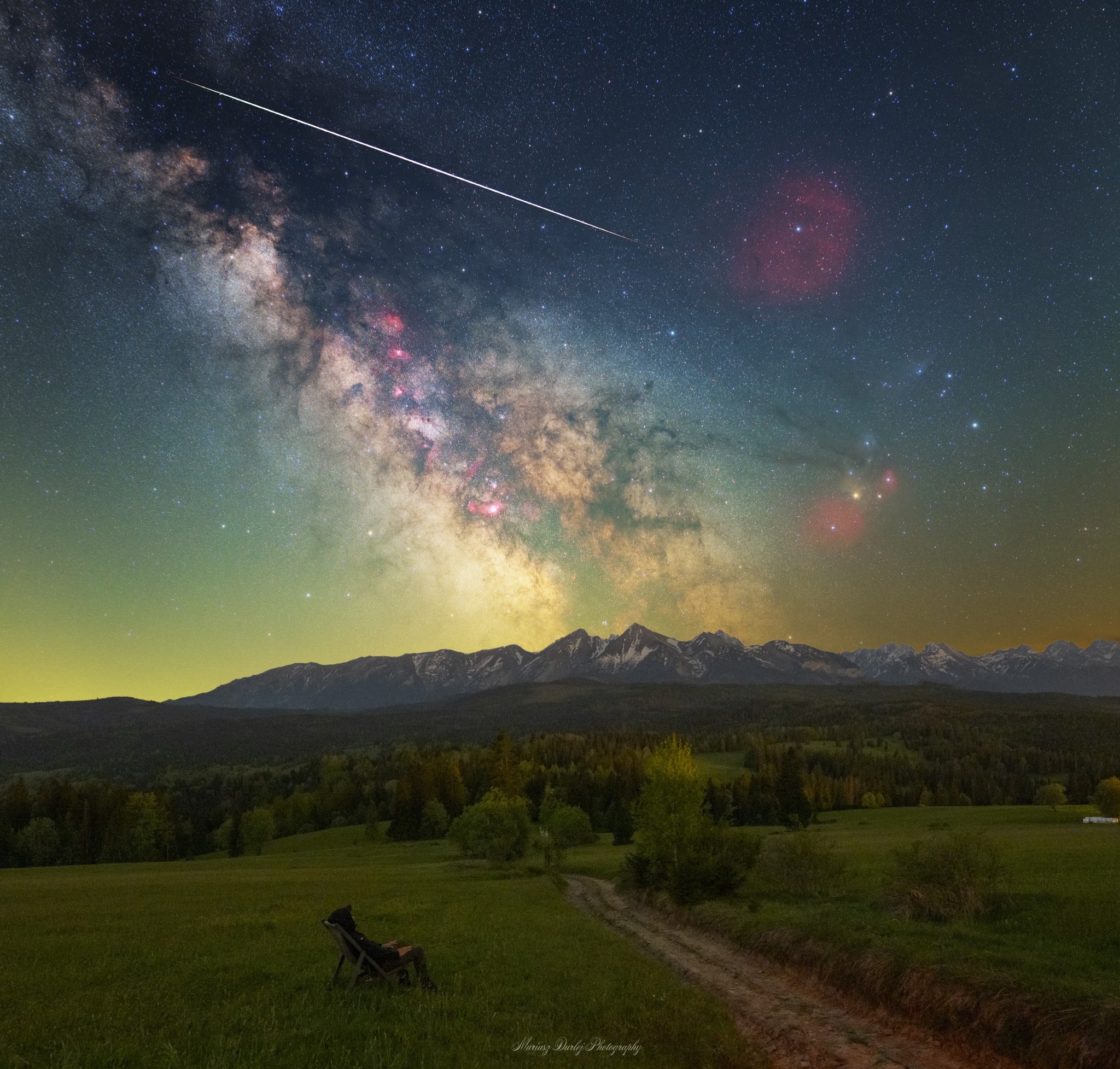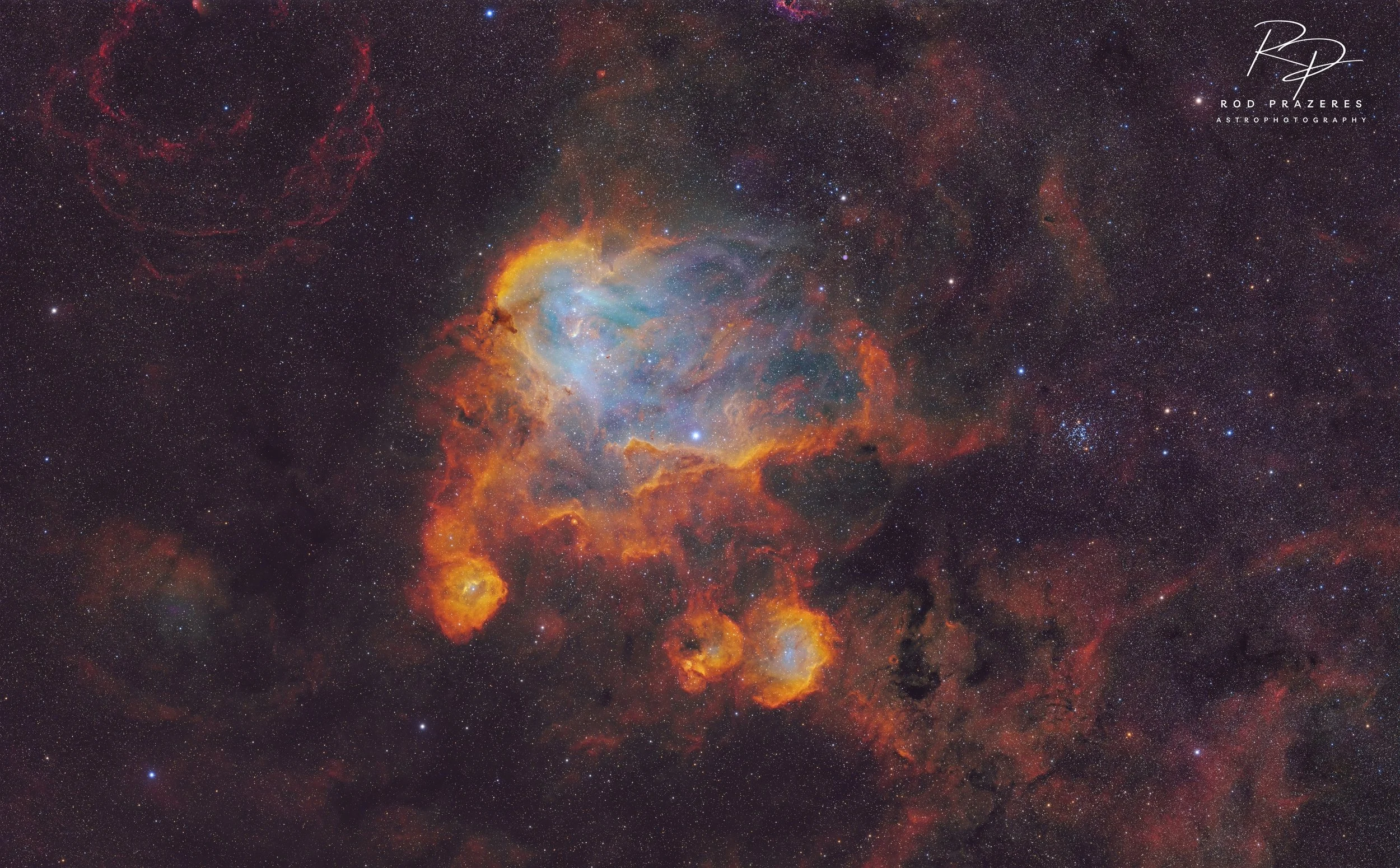
AAPOD2 Image Archives
Sun with sunspot 3664 and solar prominences
Captured amidst the vast expanse of space, the Sun shines as a radiant sphere of light and energy, showcasing intricate details of its dynamic surface. Amidst the swirling maelstrom of solar activity, Sunspot 3664 emerges as a LARGE darkened blemish on the Sun's photosphere, signifying regions of intense magnetic activity. These sunspots are cooler areas on the Sun's surface, caused by concentrated magnetic fields inhibiting the flow of heat, creating a stark contrast against the surrounding brilliance.
Accompanying this celestial display are solar prominences, towering arcs of plasma that extend high above the Sun's surface, reaching heights of tens of thousands of kilometers. These fiery tendrils of ionized gas, sculpted by the Sun's magnetic field, mesmerize observers with their graceful dance across the solar limb. As the Sun rotates and evolves, these prominences continually shift and change, providing astronomers with valuable insights into the Sun's dynamic behavior and the nature of its magnetic environment. Through careful observation and scientific inquiry, we continue to unravel the mysteries of our nearest star, the life-giving Sun, and its profound influence on the cosmos.
The magnificent Sombrero galaxy (M104)
The Sombrero Galaxy, also known as Messier 104 or M104, stands as a celestial marvel in the constellation Virgo, captivating astronomers and stargazers alike with its distinctive appearance. This stunning spiral galaxy boasts a prominent dark dust lane that bisects its bright central bulge, resembling the brim of a sombrero hat, from which it derives its name. Located approximately 28 million light-years away from Earth, M104 spans about 50,000 light-years in diameter, making it one of the most massive galaxies in the nearby universe.
Its striking appearance is further accentuated by a vibrant halo of globular clusters, open clusters, and young blue stars that adorn its spiral arms, contributing to its overall grandeur. While its central bulge harbors a supermassive black hole, which is estimated to be about 1 billion times the mass of the Sun, the Sombrero Galaxy continues to intrigue scientists with its intricate structure and evolutionary history. Through the lens of telescopes and the wonders of astrophotography, M104 offers a glimpse into the cosmic ballet of galaxies, inspiring awe and curiosity about the mysteries of the universe.
SUN
On May 6, 2024, at 10:30 a.m., a captivating glimpse of the solar photosphere was captured, revealing intricate details of our nearest star's surface. The photo showcases the dynamic and ever-changing nature of the Sun, with prominent features such as sunspots, granules, and faculae dotting its fiery surface.
Sunspots, dark regions caused by intense magnetic activity, stand out against the brighter background of the photosphere. These cooler areas are often associated with increased solar activity and can persist for days or even weeks before fading away. Meanwhile, granules, small cellular structures that form as hot plasma rises and cools on the Sun's surface, create a textured appearance reminiscent of a bubbling cauldron. Interspersed among these granules are faculae, bright patches that indicate regions of enhanced magnetic activity and are often found near sunspots. This mesmerizing image offers a glimpse into the dynamic and complex nature of our Sun, reminding us of its vital role in sustaining life on Earth while captivating our imagination with its celestial beauty.
M51 and distant background Galaxies
The iconic whirlpool galaxy, M51, takes center stage in this stunning astrophotograph, surrounded by a backdrop of distant background galaxies. Located approximately 23 million light-years away in the constellation Canes Venatici, M51 showcases its spiral arms adorned with bright knots of star formation and intricate dust lanes. Its gravitational influence is evident as it interacts with smaller companion galaxies, creating tidal tails and triggering bursts of new stellar activity.
Amidst the serene expanse of space, the faint glimmers of distant background galaxies add depth to the cosmic tapestry. Each speck of light represents a distant island universe, billions of light-years away from our own Milky Way galaxy. Together, they form a breathtaking vista of celestial splendor, inviting viewers to contemplate the vastness of the cosmos and the interconnectedness of galaxies across the universe.
Fireball over the Bielskie Tatra Mountains
A spectacular fireball streaks across the night sky above the Bielskie Tatra Mountains, leaving a trail of brilliance in its wake. This captivating scene captures the fleeting yet mesmerizing beauty of a meteor as it blazes through Earth's atmosphere. The Bielskie Tatra Mountains provide a dramatic backdrop for this celestial spectacle, their rugged peaks standing in stark contrast to the serene night sky.
As the fireball illuminates the darkness, it serves as a reminder of the dynamic and ever-changing nature of our universe. Meteor showers like this one offer astronomers and enthusiasts alike the opportunity to witness the remnants of cosmic debris interacting with our atmosphere, creating dazzling displays of light. Moments like these inspire wonder and curiosity, encouraging us to gaze skyward and contemplate the mysteries of the cosmos.
The Grand Spiral Galaxy M100 (NGC 4321)
M100, also known as NGC 4321, stands as a majestic example of a grand spiral galaxy, nestled within the constellation Coma Berenices. With its sweeping spiral arms and bright core, M100 exhibits intricate patterns of star formation and stellar activity across its vast expanse. Spanning approximately 107,000 light-years in diameter, M100 ranks among the largest galaxies in the Virgo Cluster, a rich cluster of galaxies located some 55 million light-years away from Earth.
As one of the brightest members of the Virgo Cluster, M100 offers astronomers a wealth of insights into the dynamics of galactic evolution. Its spiral arms are adorned with regions of intense star formation, where massive stars are born from the gravitational collapse of dense molecular clouds. Additionally, M100 harbors a supermassive black hole at its center, whose gravitational influence shapes the galaxy's structure and influences its surrounding environment. By studying galaxies like M100, astronomers gain valuable knowledge about the processes driving the formation and evolution of galaxies throughout the universe.
M13 Hercules' Diamonds
M13, also known as the Great Globular Cluster in Hercules, is one of the most remarkable objects in the northern sky. Situated in the constellation Hercules, this globular cluster is a densely packed sphere of hundreds of thousands of stars held together by gravity. Its compact core shines brilliantly, while its outer regions extend in a vast halo of fainter stars.
Located approximately 22,200 light-years away from Earth, M13 is one of the brightest and largest globular clusters visible from the Northern Hemisphere. Its age is estimated to be around 12 to 13 billion years old, making it one of the oldest known objects in the Milky Way galaxy. Studying M13 provides astronomers with valuable insights into the formation and evolution of globular clusters, offering a window into the early history of our galaxy.
M 25 - bright and colorful stars in front of a sea of stars
M25, also known as the IC 4725 open cluster, is a dazzling assembly of stars situated in the constellation Sagittarius. This cluster shines brightly against the backdrop of the Milky Way, appearing like a jewel in the night sky. Comprising hundreds of stars, M25 presents a breathtaking display of stellar diversity, with stars of various colors and magnitudes dotting its celestial canvas.
The cluster's proximity to the galactic plane makes it immersed in a sea of stars, enhancing its visual appeal and creating a mesmerizing tapestry of light. With its rich concentration of stars and intricate patterns, M25 offers astronomers and stargazers alike a captivating glimpse into the beauty and complexity of our galaxy.
"Radiant Canopy": The Lustrous Realms of the Running Chicken Nebula
The Running Chicken Nebula, formally known as IC 2944, is a star-forming region located in the constellation Centaurus. Resembling a chicken running through space, this striking nebula is a vibrant tapestry of gas and dust, illuminated by the intense radiation of young, hot stars nestled within its midst. Stretching across approximately 100 light-years, IC 2944 is part of a larger complex of star-forming regions in the Centaurus OB association.
This captivating nebula is a prime example of the dynamic processes shaping our universe, where stellar winds and radiation from massive stars sculpt the surrounding gas clouds, giving rise to intricate structures and fostering the birth of new stars. Its distinct appearance has earned it a place among the most iconic and visually stunning objects in the southern sky, captivating astronomers and stargazers alike with its celestial charm.

